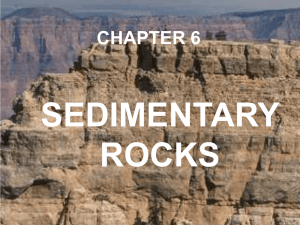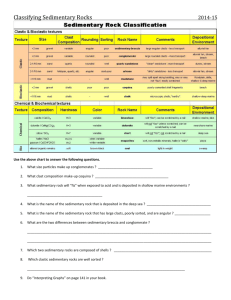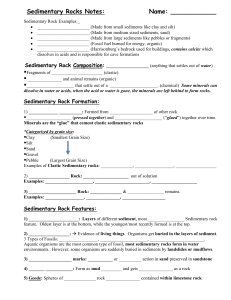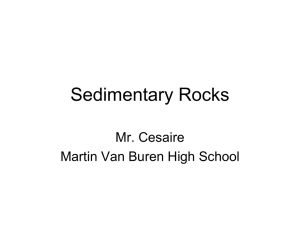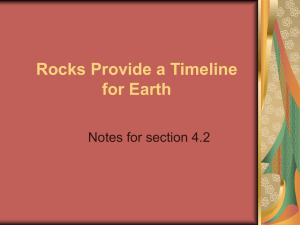Sedimentary Rocks
advertisement
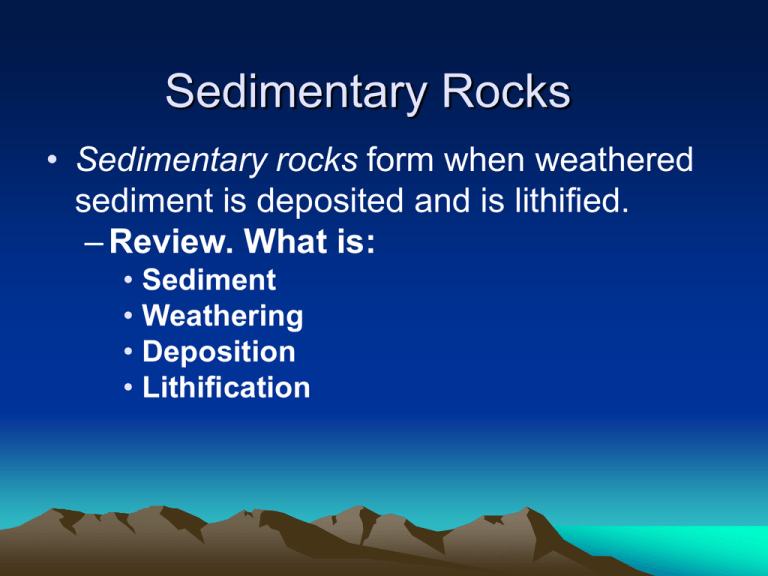
Sedimentary Rocks • Sedimentary rocks form when weathered sediment is deposited and is lithified. – Review. What is: • Sediment • Weathering • Deposition • Lithification Formation of Sedimentary Rocks • Lithification? – The process of cementing and/or compacting sediment together. • In the lab we did the other day (sand and food), which one represented compaction and which one represented cementation and why? • What is an evaporite? – Rocks that form after water has evaporated Subclasses of Sedimentary Rocks • What’s a subclass? • Sedimentary rocks are sub-classified by the processes by which the rocks form and by the composition of the rocks. • The three main sub-classes of sedimentary rocks are: – Clastic – Chemical – Organic Clastic Sedimentary Rock • Clastic is Latin for “broken.” • Clastic sedimentary rocks form when fragments of preexisting rocks are compacted or cemented together • Clastic sedimentary rocks are classified by the size and shape of the sediments they contain. Classification of Clastic Sedimentary Rocks Sediment Size Large Sediment Shape Rounded Rock Name Conglomerate Small – Large Angular Breccia Small Rounded Sandstone Very Small (clay or Mud Sized) Rounded and/or Shale Angular Characteristics of Clastic Sediments • The physical characteristics of sediments are determined by the how much weathering took place before lithification. – Lots of weathering = smaller and rounded sediment – Little weathering = larger and more angular sediment Characteristics of Clastic Sediments • The tendency for currents of air or water to separate sediments according to size is called sorting. – Happens during weathering and erosion – Well-sorted sediments, all of the grains are roughly the same size and shape. – Poorly sorted sediment consists of grains that are many different sizes. Chemical Sedimentary Rocks • chemical sedimentary rocks form when minerals precipitate (solid out of liquid) when water evaporates. • When water evaporates, the minerals that were dissolved in the water are left behind. – What lab was this like? • Rocks that form through evaporation are called evaporites. Rock gypsum and rock salt are common evaporites. Organic Sedimentary Rocks • organic sedimentary rocks form from the remains of plants or animals • Coal and some limestones are examples of organic rocks (shell limestone, coquina, and chemical limestone). • Organisms such as clams and coral make their shells from minerals. When the organism dies, their shells settle to the bottom of the ocean, accumulate, and are compacted and/or cemented to form limestone. Organic Sedimentary Rocks The diagram below shows the formation of organic limestone. Sedimentary Rock Summary Parent Material Rock Minerals Class Round pebbles Conglomerate Any Clastic Angular sediment Breccia Any Clastic Sand Sandstone Mostly quartz Clastic Clay Shale Mostly feldspar clastic Dissolved salt Rock salt Halite Chemical Dissolved gypsum Rock gypsum Gypsum Chemical Dead plants loosely compacted Peat Organic Dead plants tightly compacted Bituminous Coal Organic Cemented shells Shell limestone Calcite Organic Compacted shells Coquina Calcite Organic Dissolved shells Chemical limestone Calcite chemical



